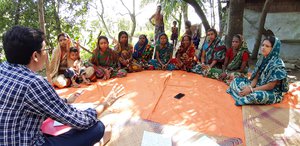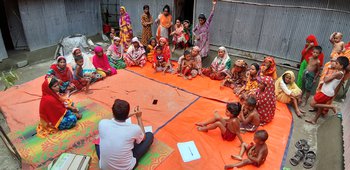A case study on writing a peer-reviewed journal article on climate change
This case study is about writing an original peer-reviewed journal article on climate change research by three authors from Bangladesh. This briefly describes the context of and motivation for the research, and strategies taken to collect data (as a part of research design) and to write the article. The peer-review process is a crucial part of publishing an article ― lessons from this article are described as well. The open access experience and beyond publication impact of this article are also touched upon. Finally, examples are given how this article-writing strategy is followed in similar articles by the same research team.

[Caption: A focus group discussion in a remote village in the Tahirpur sub-district of the Sunamganj district, Bangladesh. (Photo: Haseeb Md. Irfanullah)]
- The open access article relevant to this discussion was published online on 8 January 2021 in Climate Risk Management, an Elsevier journal. Its full citation is given below:
Bhowmik, J., Irfanullah, H.Md., & Selim, S.A. (2021). Empirical Evidence from Bangladesh of Assessing Climate Hazard-related Loss and Damage and State of Adaptive Capacity to Address it. Climate Risk Management, 31, 100273. DOI:https://doi.org/10.1016/j.crm.2021.100273
- This article is based on a piece of research conducted in the second half of 2019 in Bangladesh.
- All three authors of this article are from Bangladesh ― a Group A country as per the Research4Life classification.
1) Why is this research important?
- Climate change is a global crisis. As we set targets to reduce carbon emissions by the next couple of decades, at the same time we need to continue to adapt/adjust to the expected, and already realised, impacts of climate change. However, climate change adaptation has its limits.
- Disasters are now intensifying and becoming increasingly frequent all over the world. These are now causing serious losses and damage, which cannot be effectively tackled by adaptation measures alone. These losses and damages could be both economic (e.g., asset or crop losses) and non-economic (e.g., mental or physical wellbeing).
- While we have been increasingly talking about ‘Loss & Damage’ as a climate change concept, evidence of real losses and damages from the ground is limited. This is especially true for the climate-vulnerable countries from the Global South, such as Bangladesh.
- This study estimated the economic loss and damage of individual households in three locations in Bangladesh in the housing, agriculture, and health sectors (i.e., US$ 568―US$ 1054 per household per latest extreme climate event). It also identified changes in productive land, stressed mental and/or physical wellbeing, temporary migration, and permanent shifts in professions as non-economic losses and damages. The research further showed that households that had access to ICT did better at coping with disasters and adapting to climate change by using new information, technologies, and training and enjoyed better entrepreneurial skills, leadership quality, and social/institutional networks.
2) What motivated you to conduct this research?
- The above knowledge gap regarding a lack of evidence of losses and damage was not only evident in the global literature, but it was also frequently raised and discussed by leading climate change experts at different climate change forums.
- The research team at the Center for Sustainable Development (CSD) of the University of Liberal Arts Bangladesh (ULAB), Dhaka, realised this research need. But an opportunity only came for conducting a piece of research in the middle of 2019 under a consultancy for Oxfam in Bangladesh (an international non-governmental organisation). This opportunity was indeed expedited by a Memorandum of Understanding (MoU) signed between the CSD/ULAB and Oxfam, since both organisations wanted to create a space for collaboration between a research organisation and a development organisation.
3) How did you design the research?
- The research was designed and conducted by three researchers of the CSD-ULAB who previously hadn't conducted any research on the concept of Loss & Damage in the context of climate change.
- A core strategy was taken to design a good quality research project which had three parts (for full references to the citations given below, please consult Bhowmik et al., 2021).
- The research team searched for and selected a published analytical framework (van der Geest and Schindler, 2017) to develop their data collection protocol on the first aspect of the research (i.e., losses and damages): see Section 2.1 and Figure 1 in Bhowmik et al. (2021).
- To present the non-economic losses and damages, the team relied on another established classification or protocol (Tschakert et al., 2019; Section 3.3, Table 4).
- The team also used an existing theoretical framework (Jones et al., 2019) to present the collected data on the second aspect of the research (i.e., adaptive capacity) (Section 2.2; Figure 2).
- Based on these, the research team designed the research to build evidence by gathering data and information on losses and damage from the most recent disaster(s) in three different disaster-prone locations in Bangladesh.
- Focus Group Discussions (FGDs) and Key Informant Interviews (KIIs) were conducted to collect data and information on economic and non-economic losses and damage and adaptive capacity. Consult Section 3 of Bhowmik et al. (2021) for the detailed methodology.
4) What steps did you take in writing the article?
- A modest literature review of the global literature helped the authors to write the Introduction (Section 1) and analytical/theoretical framework (Section 2) sections of the article.
- The Introduction describes the context of the study, our present theoretical understanding, the prevailing knowledge around the core issues, the current knowledge gap, and connecting all to the study country (Bangladesh).
- This led to identifying the three research objectives to end the Introduction.
- Since the article is based on three analytical/theoretical frameworks, a separate section (Section 2) briefly described them for the readers’ convenience.
- The Methodology (Section 3) described in detail every step followed for data collection and data analysis, so that any future researchers can replicate the methods followed.
- The Results section was organised based on the analytical/theoretical frameworks used for data collection: first framework (Sub-sections 4.1–4.5), second framework (Sub-section 4.6), and third framework (Sub-section 4.7).
- This was a very useful strategy to arrange all quantitative and qualitative data in appropriate clusters without any repetition or overlap.
- The first four sub-sections (5.1–5.4) of the Discussion section deal with four major issues identified from the research findings or results which needed explanation and interpretation by comparison with previous relevant studies.
- The last sub-section (5.5) of the Discussion deals with a new conceptual framework, which was added later in response to a peer reviewer’s comment. Details of it are described in the following section, on the peer-review process.

[Caption: A focus group discussion in a remote village in the Dimla sub-district of the Nilphamari district, Bangladesh. (Photo: Haseeb Md. Irfanullah)]
5) What are your tips for collaborative writing?
- While writing an article with multiple authors (from the same or different organisations), it is crucial to clearly define the roles of each author at the beginning of the writing project.
- An activity plan with tentative deadlines is essential to ensure the sequence of activities and coordinate among the authors.
- Google Doc or similar shared drives are useful in collaborative writing where multiple authors can contribute at the same time as needed without sharing multiple versions via email.
- It is vital that one author, usually the first/corresponding author, acts as the focal point for all writing-related activities.
- All authors should respond to the respective actions by agreed deadlines. This is important especially when responding to the editor’s/reviewers’/publisher's comments.
- In some cases, the first/corresponding author may need to take drastic decisions to move forward with the writing project.
- All authors must approve a version before submitting it to a journal as the first submission or submission of the revisions.
6) How did you select a suitable journal?
- One of the best ways of selecting a journal to submit a manuscript to is from the ones we cited in our own manuscript.
- The quality of our research often determines where to submit our manuscripts. Very high quality/impact factor journals would not publish something which does not advance the discipline significantly. It will therefore be a waste of time to submit to such a journal.
- We must have a clear idea to which type of journals we are submitting our article: i) subscription journal (articles can only be read by the subscribing institutions), ii) open access journal (where authors pay Article Processing Charges or APCs to make the articles open for anyone with an internet connection), or iii) hybrid journals (which publish both open access articles and non-open access articles).
- We also need to check if we are supposed to pay any fees.
- We must check the APC waiver/discount policy on the journal website. In the present case study, since all three authors of Bhowmik et al. (2021) were from a Ressearch4Life’s Group A country (Bangladesh), they received a 100% wavier to publish this paper open access.
- Please consult the useful tips available on this website before submitting a manuscript to avoid journals operating unethical practices: https://thinkchecksubmit.org/
7) What did you learn from the peer review process?
- One important element of the article in question was included after the first round of peer review. One reviewer indicated that, since this research is based on several existing frameworks, how does it advance the concerned discipline with its unique theoretical contributions.
- In response to that, a new conceptual framework was included in the revised manuscript, which captured the interplay between two separate concepts as discussed above, i.e., ‘Loss & Damage’ and ‘adaptive capacity’ in the climate change space (Section 5.5; Figure 3 of the article).
- In addition to the above comment, both peer reviewers of the manuscript under discussion were very supportive while providing comments to improve the article.
- They apparently appreciated the fact that this type of research was needed to come from the Global South or, more specifically, from climate-vulnerable countries such as Bangladesh.
- Such a positive attitude encouraged the authors to address all reviewers’ comments as sufficiently as possible.
- This is also an important lesson for the authors since they also act or will be acting as peer-reviewers for other journals.
8) What happened to this article after it was published?
- The Inter-governmental Panel on Climate Change (IPCC) is a leading international organisation which publishes Assessment Reports on climate change every 5–7 years. These reports are essentially based on published peer-reviewed articles. (Read a related article on The Scholarly Kitchen).
- The latest IPCC’s Sixth Assessment Report (Climate Change 2022: Impacts, Adaptation, and Vulnerability) by Working Group II was published in February 2022, just one year after Bhowmik et al. (2021) was published.
- Bhowmik et al. (2021) was cited several times in the latest IPCC Report (Chapters 4, 10 and 18), indicating the global value of the research conducted in Bangladesh, only by Bangladeshi researchers.
- From an institutional point of view, this has also been a great milestone for the CSD/ULAB, whose research was for the first time quoted by this prestigious report.
9) Is it possible to replicate the above article-writing model/strategy?
- Building on the existing analytical, conceptual or theoretical frameworks is a good strategy for early-career researchers as they design research and write articles.
- Two more examples of articles written on resilience issues by the same research team are given below, where a similar strategy was followed.
Bhowmik, J., Selim, S.A., Irfanullah, H.Md., Shuchi, J.S., Sultana, R., & Ahmed, S.G. (2021). Resilience of Small-Scale Marine Fishers of Bangladesh Against the COVID-19 Pandemic and the 65-Day Fishing Ban. Marine Policy, 134, 104794. DOI:https://doi.org/10.1016/j.marpol.2021.104794
Sultana, R., Irfanullah, H.Md., Selim, S.A., Raihan, S.T., Bhowmik, J., & Ahmed, S.G. (2021). Multilevel Resilience of Fishing Communities of Coastal Bangladesh Against Covid-19 Pandemic and 65-Day Fishing Ban. Frontiers in Marine Science, 8, 1419. DOI:https://doi.org/10.3389/fmars.2021.721838
